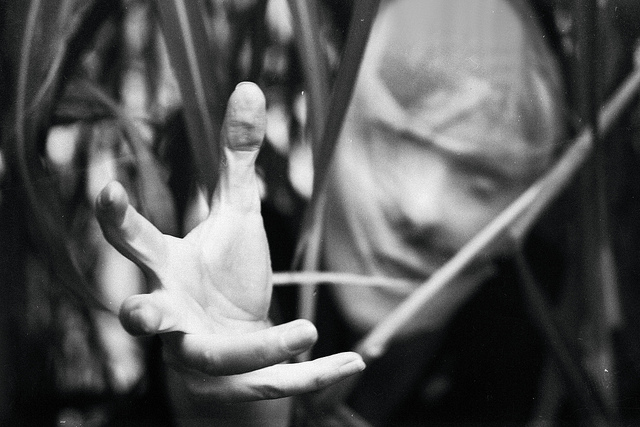Fridays With Roy: Celebrate Halloween With A Spooky New Barry Gifford Story
By Barry Gifford in Arts & Entertainment on Oct 30, 2015 4:45PM
There are those of us who prefer to spend Halloween in a darkened room, watching scary movies. But bingeing on horror TV isn't a recent development, as Barry Gifford's story "Dark and Black and Strange" demonstrates. This evocative slice of '50s spookiness, like the other stories in our Fridays with Roy series, is drawn from a work in progress tentatively titled The Cuban Club. So dim the lights, grab on to someone tightly, and enjoy. And be sure to come back next week for another new story!
by Barry Gifford
As a boy, Roy often stayed up much of the night watching movies on TV. Most of them were old, black and white films from the 1930s and ’40s. When he and his mother were living in hotels in Miami, Havana or New Orleans, she was usually out during the late night and early morning hours, leaving Roy by himself, which he did not mind; when they were in Chicago, staying at his grandmother’s house, he had a little television in his room to watch the all-night movies on channel nine, a local station that owned an extensive archive of classic as well as obscure films.
The movies Roy preferred were mystery, crime and horror pictures such as The End of Everything, Stairway to Doom, Three-and-a-Half Jealous Husbands, Fanged Sphinx of Fez, and Demented Darlings. By far his favorite was Snake Girl, starring Arleena Mink, a purportedly Eurasian actress of uncertain provenance, who never made another movie. Unlike Cult of the Cobra, also one of Roy’s favorites, which featured a woman who turned into a viper in order to commit murders, Snake Girl was about a child abandoned, supposedly by her parents, in a swamp for unexplained reasons.
When first we see Arleena Mink, an exotic-looking, stunningly beautiful teenage girl, unclothed but covered in strategic places by what appears to be a sheer coating of dark moss, her amazingly long, dark hair entwined around her neck, upper arms, waist and legs, she is not really walking but gliding in a dreary landscape both jungle and swamp. She deftly navigates her way through and beneath hanging moss and reptilian vines, sinuously evading gigantic Venus flytrap types of plants and overgrown vegetation. The only noises come from invisible birds that constantly squawk and screech. Her passage is interrupted briefly by an apparent flashback showing a car stopping on a road next to a swamp, the right front passenger door opening, and a person’s hands and arms holding and then rolling a bundle—presumably containing the body of an infant—down an incline into the murk. The door closes and the car is driven on. We do not see the driver or passenger’s faces.
Arleena Mink does not utter a sound other than an occasional hiss. Four men carrying rifles, machetes and nets appear, attired in khaki bush jackets and safari hats. They don’t talk much as they plod past waving leaves and wade through brackish shallows. We assume they are hunting for the snake girl, whose existence, we learn from their minimal dialogue, may be only a rumor. Having seen Arleena Mink, however, we know her presence in the swampland is not a myth and she is apparently endeavoring to avoid capture.
Arleena slithers, slinks and crawls as her pursuers become increasingly frustrated due to biting insects, unidentified moving things rippling the waters, and debilitating heat. The action concludes when one after another the men are eliminated: the first two sucked under and swallowed by quicksand, the third strangled by a serpent-vine, and the fourth dragged into dense foliage by the hairy arm of an otherwise unseen beast, the victim’s cry muffled by one huge, sharp-clawed paw.
The snake girl may or may not have even been aware that she was being stalked by men; behaving cautiously is her natural condition. In the last shot of the movie she rises to her full height, stares directly into the camera, her slanted eyes burning and sparkling like black diamonds, and from between her puffy lips darts a shockingly long, whiplike tongue. The forked tip of Arleena Mink’s quivering organ flaps and twists as she emits a sudden, deliciously hideous, spine-shriveling hiss.
Whenever Roy saw Snake Girl listed in a TV movie guide—without exception in the middle of the night—he watched it. Arleena Mink disappeared from public display after 1944, the year her one film was made. It wasn’t until almost fifty years later that by chance Roy noticed an obituary in Variety that read: “Arleena Mink, actress, born Consuelina Norma Lagarto in Veracruz, Mexico, on January 1, 1930, died June 20 in Asunción, Paraguay. Her husband, Generalissimo Emilio Buenaventura-Schmid, whom she married when she was fifteen years old, preceded her in death, date unknown. Miss Mink’s only film appearance was in Snake Girl, rumored to have been secretly directed in Brazil by Orson Welles, using the name Mauricio de Argentina. Writing in Le Monde (Paris), the eminent critic Edmund Wilson described Snake Girl as ‘an erotic masterpiece, uniquely dark and black and strange. One can easily imagine being bitten by the vixenish, barely pubescent Arleena Mink and expiring without regret.’ ”
